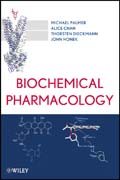
This book explains the biochemical principles of drug action, to students of biochemistry and related scientific disciplines. For each drug discussed, the authors provide the biochemical concepts needed to understand its function. They explain some of the experimental methods used to characterize drugs and their receptors, together with examples of the evidence that these methods provide. Clinical and physiological aspects are outlined where useful to appreciate the significance of a drugs action. Finally, the authors point out some of thequestions that remain to be solved by future researchers. End-of-chapter exercises encourage self-evaluation and further reading. The text contains many illustrations that also are available to course instructors as PowerPoint slides. INDICE : Preface Acknowledgments 1 Introduction 1.1 Origin and preparationof drugs 1.2 Drugs and drug targets 1.3 Drug molecules may or may not resemble the physiological ligands of their receptors 1.4 Strategies of drug discovery and development 2 Pharmacodynamics 2.1 Molecular features of drug-receptor interaction 2.2 Theory of drug-receptor binding 2.3 Dose-effect relationships in signaling cascades 2.4 Potency and efficacy 2.5 Beneficial and toxic drug effects 2.6 Appendix 3 Pharmacokinetics 3.1 Anatomical barriers to drug transport 3.2 Solute transport across cell membranes 3.3 Drug application 3.4 Drug distribution 3.5 Drug elimination via the kidneys 3.6 Quantitative experimental methods in pharmacokinetics 4 Drug metabolism 4.1 Overview: Possible functionaloutcomes of drug metabolism 4.2 Phase I and phase II reactions 4.3 CytochromeP450 4.4 Reductive drug metabolism 4.5 Conjugation reactions 4.6 Enzyme induction 4.7 Metabolism-related toxicity as a therapeutic target 5 G protein-coupled receptors 5.1 Overview 5.2 GPCR structure 5.3 Structural GPCR families 5.4 Activation of GPCRs 5.5 GPCR dimerization and oligomerization 5.6 G proteins 5.7 GPCR phosphorylation, endocytosis, and G protein independent signalling 5.8Appendix 6 Pharmacology of cell excitation 6.1 Ions, pumps and channels 6.2 ATP-driven active ion transport 6.3 Voltage-gated channels and the action potential 6.4 Channels controlled by intracellular ligands 6.5 Transient receptor potential (TRP) channels 6.6 Voltage-gated channels of nerve cells as drug targets 6.7 Synaptic transmission 6.8 Pharmacology of individual transmitters 6.9 Appendix 7 Hormones 7.1 Hormone receptors 7.2 The hypothalamus and the pituitary gland 7.3 Thyroid gland hormones 7.4 Steroid hormones 7.5 Endocrine controlof bone mineralization 8 Pharmacology of nitric oxide 8.1 Characterization ofnitric oxide as a biological signaling molecule 8.2 Nitric oxide synthase andits isoforms 8.3 Biochemical mechanisms of NO signaling 8.4 The biological function of iNOS 8.5 NO-releasing drugs 8.6 NOS inhibitors 8.7 Phosphodiesteraseinhibitors 9 Eicosanoid mediators and related drugs 9.1 Biosynthesis of eicosanoids 9.2 The cyclooxygenase reaction 9.3 Cyclooxygenase isoforms and inhibitors 9.4 Phospholipase A2 inhibitors 9.5 Derivatives of prostaglandin H2 and related drugs 9.6 Lipoxygenases, leukotrienes and related drugs 9.7 Eicosanoids synthesized by cytochrome P450 9.8 Endocannabinoids and related drugs 9.9 The role of poly-unsaturated fatty acids in eicosanoid signaling 10 Intermediate metabolism, diabetes and atherosclerosis 10.1 Hereditary enzyme defects 10.2 Gout 10.3 Diabetes mellitus 10.4 Atherosclerosis 11 Chemotherapy of infectious diseases 11.1 Pathogenic microbes: Diversity and selective toxicity 11.2 Pharmacokinetic considerations 11.3 Resistance to antimicrobials 11.4 Antibacterial chemotherapy 11.5 Chemotherapy of fungal infections 11.6 Chemotherapy of parasite infections 11.7 Antiviral chemotherapy 12
- ISBN: 978-0-470-17445-6
- Editorial: John Wiley & Sons
- Encuadernacion: Cartoné
- Páginas: 416
- Fecha Publicación: 16/03/2012
- Nº Volúmenes: 1
- Idioma: Inglés
